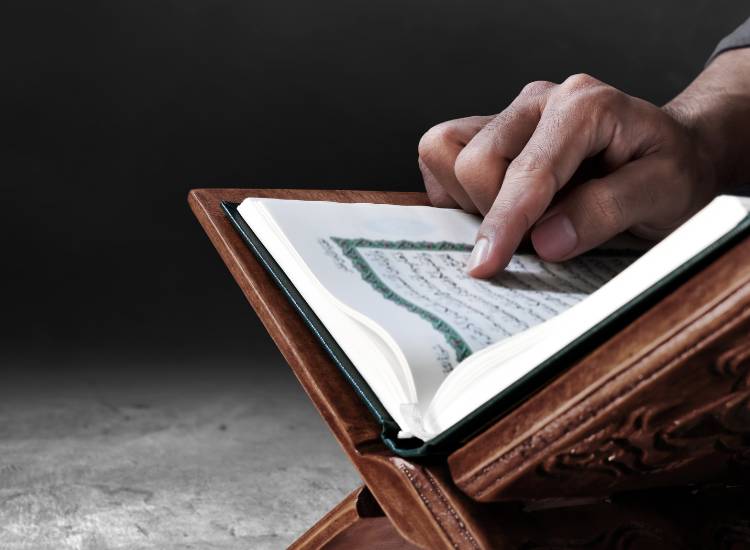Reciting the Quran is an admirable practice, but reading it with beauty and precision elevates the experience to a higher level.
To know how to read Quran with tajweed it requires adherence to specific rules, which fall under a branch of Quranic studies known as tajweed (تَجْوِيد).
Tajweed, literally meaning the beautification of Quranic recitation, focuses on the correct pronunciation of letters and words.
In this article on Madrasat El-Quran, we will discuss key aspects of tajweed and highlight some of its most essential rules to learn how to learn tajweed.
These rules are crucial for developing a good Arabic accent and mastering tajweed. By reading this article, you will gain valuable insights that will help you learn how to learn Quran with Tajweed at home.
Table of Contents
ToggleHow To Read Quran With Tajweed?
Mastering how to read the Quran with Tajweed requires a structured path, beginning with the Arabic alphabet and Tajweed rules. Enrolling in a learn Quran online with Tajweed course can greatly support consistent practice and long-term progress. For foundational skills, students may start with a learn Arabic course online to understand letters and pronunciation.
Listening to skilled reciters, participating in tilawat e Quran courses and classes, and finding a qualified teacher are essential steps in this journey. Parents can guide children by enrolling them in online Quran classes for kids to build Tajweed skills early.
Beginners should start with shorter surahs, break down complex rules into manageable parts, and record themselves for self-assessment while seeking feedback from knowledgeable individuals along the way. For overall guidance and flexible learning options, consider joining online Quran classes in USA that provide structured support for learners of all levels
Tips to Learn How to Learn Quran with Tajweed
Start with the Basics
Understanding the Arabic alphabet and its pronunciation is the foundation of Tajweed. Mastering clear articulation of each letter is fundamental to accurately applying Tajweed rules.
Understand Tajweed Terminology
Familiarize yourself with terms like “Makhaarij Al-Huroof” (articulation points) and “Sifaat Al-Huroof” (characteristics of letters). Grasping these concepts clarifies how sounds are produced, aiding in the accurate application of Tajweed rules.
Listen to Experts
Listening to proficient reciters exposes you to proper pronunciation, rhythm, and melody, helping you internalize Tajweed techniques, much like learning an instrument by observing skilled musicians.
Find a Qualified Teacher
A knowledgeable Tajweed teacher provides personalized guidance, corrects mistakes, and ensures accurate application of Tajweed rules. We offers skilled tutors who can help you learn both theoretically and practically.

Practice Regularly
Consistent practice is crucial for developing fluency in Tajweed. Regular engagement with the recitation not only reinforces learning but also deepens your spiritual connection with the Quran, transforming your practice into a journey of personal growth.
Focus on Quality, Not Quantity
Emphasize precision in recitation over speed. Prioritizing accuracy ensures that each letter is pronounced correctly according to Tajweed rules, even if it requires a slower pace.
Memorize Short Surahs
Starting with shorter surahs allows you to focus on mastering Tajweed without feeling overwhelmed. This gradual approach builds confidence and competence, laying a strong foundation for more complex recitations.
Break Down Complex Rules
Simplify complex Tajweed rules by breaking them into smaller, understandable segments. This method enables effective learning and application of each rule before moving on to more advanced concepts.
Use Tajweed Guides
Utilize Tajweed resources for detailed explanations and examples, making the learning process more structured and accessible.
Record Yourself
Just as a mirror helps you refine your appearance, recording your recitations offers a clear perspective on your Quranic progress, allowing you to identify strengths and weaknesses.
Seek Feedback
Constructive criticism from teachers or peers accelerates your progress by pinpointing areas needing improvement.
At Madrasat El-Quran, regular feedback is prioritized to help learners stay on track and elevate their proficiency.
Be Patient and Persistent
Mastery of Tajweed is a gradual process requiring dedication and perseverance. Embrace the journey, understanding that each effort contributes to your improvement.
Review Regularly
Periodic review sessions reinforce your understanding of Tajweed rules and prevent knowledge decay, ensuring that the principles remain fresh and correctly applied.
Supplicate for Guidance
Seek Allah’s assistance through supplication, strengthening your connection to the Quran and trusting in divine guidance on your journey to mastering Tajweed.
Immerse Yourself in Recitation
Integrate Quranic recitation into your daily routine, allowing constant exposure to proper pronunciation and internalization of Tajweed rules, similar to language immersion.
Join Tajweed Classes or Study Groups
Participating in tajweed classes or study groups fosters a sense of community and accountability, enhancing your comprehension and retention of Tajweed principles through peer support and structured learning.
Utilize Technology
Leverage Tajweed apps, websites, and online courses that offer interactive features and audiovisual resources, catering to different learning styles and making Tajweed accessible for all levels.
Set Specific Goals
Define clear, measurable objectives for your Tajweed practice, such as mastering a specific rule or improving recitation speed, providing direction and motivation as you progress.
Reflect on the Meaning
While focusing on the technical aspects, don’t lose sight of the spiritual dimension. Reflect on the meaning of the verses you recite, connecting with the Quran’s profound message, and imbuing your recitation with deeper sincerity and reverence.
Given the major importance of learning how to read Quran with tajweed, we at Madrasat El-Quran offer you the best course for proper Quran recitation, taught by native arab tutors, graduates of renowned Islamic universities.

Time To Learn Holy Quran With Tajweed
For completion of the answer to how to read Quran with Tajweed, there are factors that affect learning Quran with Tajweed period.
For beginners with no prior knowledge of Arabic, it typically takes around 6 to 12 months to master the basic Tajweed rules. This estimate is based on attending regular online lessons (2–3 times a week) combined with consistent personal practice.
Mastering Tajweed is a journey that requires dedication and patience as you familiarize yourself with the sounds and rules of Quranic recitation. There are some factors that influence this process:
Prior Knowledge:
If you already have some familiarity with Arabic and Quranic recitation, you may recognize certain sounds and pronunciation patterns, which can accelerate your learning.
However, if you’re new to Arabic or Quranic recitation, you’ll need to spend more time mastering the basics of arabic before moving on to Tajweed.
Frequency of Study:
Regular practice is essential for mastering Tajweed. Consistent, ideally daily, study sessions help reinforce your learning and allow you to internalize the rules more effectively. Frequent practice maintains continuity and prevents forgetting, enabling faster progress.
Individual Learning Pace:
Everyone learns at their own pace. Some may quickly grasp Tajweed rules, while others may need more time and practice. It’s important to focus on your own progress and understanding rather than comparing yourself to others.
Quality of Instruction:
A knowledgeable teacher who provides clear guidance and feedback is invaluable.
A skilled instructor can correct mistakes, clarify complex concepts, and offer encouragement, significantly enhancing your learning experience and speeding up your progress.
Commitment and Dedication:
Your dedication and commitment to practicing Tajweed are crucial to your success. Consistent effort, including regular practice, attending classes, listening to recitations, and seeking feedback, is key to mastering Tajweed.
On average, it can take several months to a few years to learn the Quran with Tajweed proficiently.
However, it’s important to prioritize accurate understanding and application of Tajweed rules over rushing through the learning process. With consistent effort and dedication, mastery will come in time.
Due to the impotence of the answer, how to read Quran with tajweed? In Madrasat El-Quran, we focus on personalized, one-on-one learning Tajweed sessions tailored to individual needs in learning Quran.

Difference Between Tajweed And Recitation
Tajweed focuses on following specific rules to ensure precise pronunciation and accurate recitation, safeguarding the original wording of the Quran. In contrast, Qirat refers to the different accepted styles of Quranic recitation, offering variations in pronunciation while preserving authenticity.

Learn to Read Quran with Tajweed Online
The Madrasat El-Quran Course, designed for mastering tajweed lessons online, provides a meticulous framework for precise and expert recitation.
This course ensures that every word is pronounced correctly, adhering to Tajweed principles.
Tajweed is essential for authentic Quranic recitation, enabling you to recite the Holy Quran with the same purity and eloquence as it was revealed to Prophet Muhammad.
Through this course, you will explore the subtleties of Tajweed, enhancing your recitation and deepening your connection to the sacred text.
Conclusion
To master how to read Quran with tajweed, begin by mastering the basics, such as learning the Arabic alphabet to ensure correct pronunciation. Familiarize yourself with Tajweed terminology, and listen to proficient reciters to internalize the nuances of proper pronunciation.
At Madrasat El-Quran, finding a qualified teacher provides you with personalized guidance tailored to your learning needs.
Practice regularly, prioritizing precision over speed, and start by memorizing shorter surahs to gradually build your confidence.
Break down complex rules into manageable parts and use Tajweed guides for a structured approach.
To excel in Tajweed, consistently record your recitations, seek constructive criticism, and remember that mastery requires patience and perseverance.
FAQs On How To Read Quran With Tajweed
What Is The Simple Rule Of Tajweed?
Noon & Meem Mushaddad:
This is a straightforward Tajweed rule that applies specifically to the letters Noon (ن) and Meem (م).
When either of these letters carries a shaddah, a two-beat ghunnah (nasal sound) must be pronounced.
This rule remains applicable even when stopping on the letter. It’s important to ensure that only the ghunnah is extended, without elongating the sound of the letter itself.
How To Recite The Quran Beautifully?
Simpely you should listen to an expert Qari, and learn how to read the Quran with tajweed.
Why Read Quran With Tajweed?
Learning the Quran with Tajweed is essential for all of us, as even a slight mispronunciation can alter the meaning of a word, which underscores the seriousness of Quranic recitation.
Tajweed rules guide you in correctly articulating each letter, helping to prevent such critical errors and ensuring the integrity of your recitation.

Madraset El Quran Academy
Madraset Elquran Academy is a world-class platform for learning Quran, Arabic, and Islamic Studies, recognized globally for its excellence. As one of the leading online Quran schools, we offer personalized one-on-one sessions with expert native Egyptian tutors, providing high-quality education for learners of all levels.



